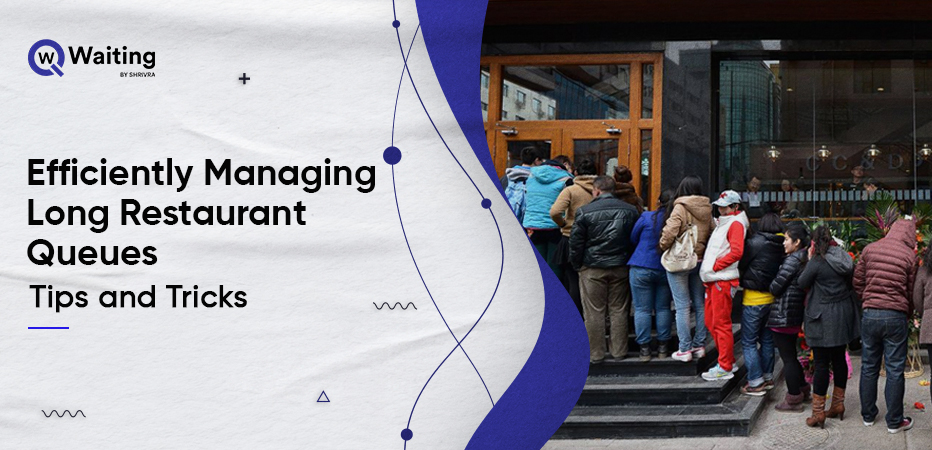
In the restaurant industry, managing long queues can be a challenging task. The wait time for customers can greatly affect their overall dining experience. Furthermore, if not managed properly, can lead to lost business and negative reviews.
Customers have little patience for long wait times and expect quick service. Restaurant owners and managers must find ways to effectively manage queues and provide a positive customer experience. In this blog, I will discuss various strategies and techniques that can be implemented to manage long restaurant queues and reduce wait times. Thus, improving the overall customer experience. From using technology to optimize seating arrangements, to implementing efficient communication systems, we’ll provide practical tips and tricks. All these will help in managing long queues in restaurants.
So, let’s dive in and explore how to efficiently manage long restaurant queues.
How to Efficiently Manage Long Restaurant Queues
Use a queue management system
Implement a queue management system like Qwaiting. It can help you manage your customers’ wait times, such as a digital queue management system or a text message-based system. It can be used to manage long queues in a restaurant in multiple ways. Some of its benefits include
- Digital Sign-in: Customers can sign in digitally using a tablet or kiosk, reducing the need for staff to take names and phone numbers.
- SMS/ Email notifications: Consumers can receive SMS or email notifications when their table is ready. Thus, reducing the need for them to wait in the physical queue.
- Virtual Queue: Customers can join a virtual queue and wait in a comfortable area until their table is ready.
Encourage takeout or delivery orders
One way to encourage takeout or delivery orders is to offer incentives for customers who choose those options, such as discounts or loyalty points. Another way is to make it easy for customers to place takeout or delivery orders by providing online ordering or mobile ordering options. Additionally, promoting takeout or delivery options through advertising and social media can also help increase awareness and demand for those options. It’s also good to have a dedicated phone line for takeout and delivery orders that is answered promptly and professionally.
Provide entertainment or amenities
There are several ways to keep customers entertained while they are waiting in a restaurant’s queue. Some examples include:
- Providing a waiting area with comfortable seating and a TV or music playing.
- Offering free Wi-Fi to customers so they can entertain themselves with their smartphones or tablets.
- Providing interactive games or activities for customers to participate in while they wait.
- Building a designated waiting area outside with a heat source during winter and coolness during summer. It will make the wait more pleasant.
In simple terms, it is vital to keep the customers engaged and entertained to assure an enjoyable waiting experience.
Staff accordingly
Ensure that you have enough staff on hand during busy periods. I greatly believe that adequate staffing ensures that the queue is managed efficiently and that customers are seated quickly. This helps to reduce wait times and improve the overall customer experience. With enough staff on hand, it is easier to provide accurate wait times and keep customers informed of any delays or changes in service. Also, having extra staff to assist customers with the digital sign-in process can help to speed up the process, reducing wait times for customers.
Provide Staff Training
Train staff on how to manage the queue efficiently. It will include how to provide accurate wait times, how to keep customers informed of any delays, and how to use any queue management tools that are in place.
Provide training to the staff on how to communicate effectively with each other, and with customers. It will ensure that any issues arising can be handled quickly and efficiently. Also, encourage teamwork among staff, and provide training on how to work effectively as a team. It will help in better management of long queues and provide a great customer experience.
Monitor and analyze queue data
Use data from your queue management system to analyze customer flow and identify patterns and trends, so you can make adjustments as needed.
For example,
- Track the number of customers in the queue at different times of the day to identify peak periods.
- Analyze the wait time for customers in the queue to determine if it is too long and identify areas for improvement.
- Use data from customer feedback or surveys to understand customer satisfaction with the wait time in the queue and make improvements accordingly.
- Use real-time data to adjust staffing levels and optimize table turnover to ensure that wait times are minimized and customer satisfaction is maximized.
Conclusion
In conclusion, several tips and strategies can be used to handle long restaurant queues. These include offering reservations, implementing a waiting list system, promoting off-peak hours, offering take-out or delivery options, expanding seating areas, and providing entertainment or distractions for waiting customers. By implementing these strategies, restaurants can help to reduce wait times and improve the overall customer experience. Additionally, effective communication and keeping the customers informed about the wait time can help to manage their expectations.
Besides, I would recommend you deploy Qwaiting, a powerful tool for efficient queue management. It comprises analytical tools for gathering insights, tracking business performance, etc. Also, it helps analyze the bottlenecks to enhance the business processes and service times.
So, what are you waiting for? Give its 14-day trial a free trial.
